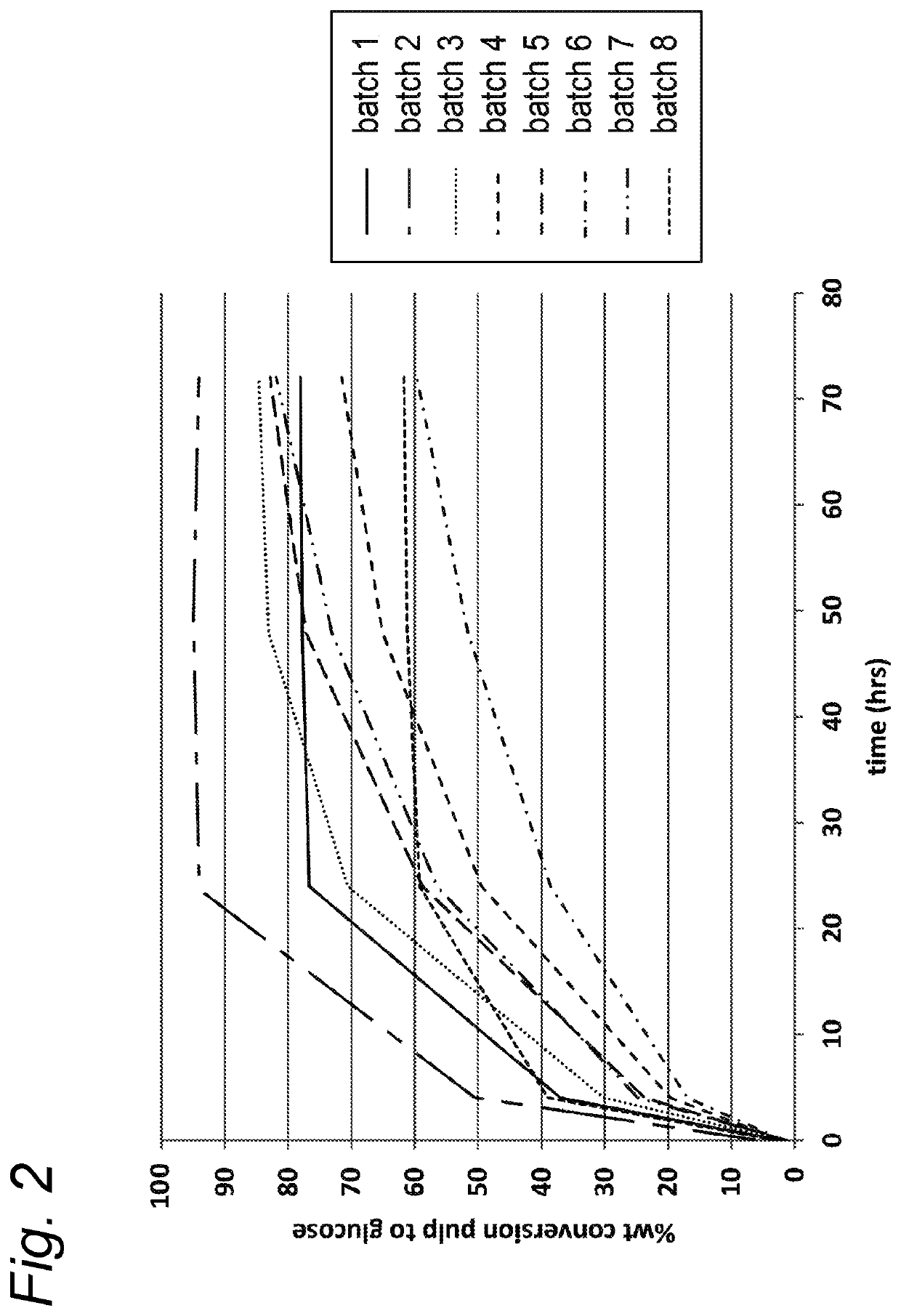Process for the treatment of lignocellulosic biomass
- Summary
- Abstract
- Description
- Claims
- Application Information
AI Technical Summary
Benefits of technology
Problems solved by technology
Method used
Image
Examples
example 1
(Pre-)Extraction+Low Temperature Organosolv+Enzymatic Hydrolysis
[0070]A first batch (batch 1) of wheat straw was pre-extracted using 10 L water per kg biomass. A second batch (batch 2) of wheat straw was first pre-extracted using the same conditions as for the first batch, and subsequently extracted with 10 L ethanol (containing about 4 wt % water) per kg biomass. Both pre-extraction and extraction were performed using a Soxhlet extractor. Both batches 1 and 2 of wheat straw were subjected to organosolv, as well as a batch of wheat straw, which has not undergone (pre-)extraction (control). Organosolv conditions employed: 140° C.; 120 min; solvent=ethanol / water (60 / 40 w / w); liquid / solid ratio=10 L / kg; 50 mM H2SO4 for the (pre-)extracted wheat straw; 60 mM H2SO4 for the control experiment. The increased H2SO4 concentration for the control experiment is to counteract the higher acid-neutralisation capacity of the mineral part of the original biomass, which is lowered during pre-extract...
example 2
(Pre-)Extraction+Organosolv
[0077]Two batches (batches 1 and 3) of wheat straw (2SO4 for the (pre-)extracted batch 1; 120 mM H2SO4 for the control batch 2. Organosolv conditions employed for batches 3 and 4: high temperature organosolv at 190° C.; 60 min; solvent=ethanol / water (60 / 40 w / w); liquid / solid ratio=5 L / kg; 30 mM H2SO4 for the (pre-)extracted batch 3; 60 mM H2SO4 for the control batch 2. The increased H2SO4 concentration for the control experiment is to counteract the higher acid-neutralisation capacity of the mineral part of the original biomass, which is lowered during pre-extraction by (partial) removal of the mineral part. In order to ensure proper wetting of the biomass when using a liquid-solid ratio of 5 L / kg, the wheat straw was placed in a porous metal basket and compressed with a mechanical press. The basket was placed in the autoclave below the level of the liquor. The liquid-solid ratio of 5 L / kg refers to the overall ratio in the autoclave.
[0078]The negative eff...
example 3
(Pre-)Extraction+Low Temperature Organosolv+Enzymatic Hydrolysis
[0083]Wheat straw was chopped into pieces of about 1 cm length, and was divided into eight batches which received different treatments as summarised in Table 6. Pre-extraction was performed on batches 2, 5 and 7, which involved extraction with 10 L water per kg biomass, and subsequently with 10 L ethanol or acetone per kg of the original biomass prior to aqueous extraction. Both pre-extraction and extraction of batches 1 and 3 were performed in a counter-current stage-wise mode. Batches 1-8 were subsequently subjected to organosolv at the indicated temperature, using the solvent system and treatment time as given in Table 6. The liquid / solid ratio was 10 L per kg biomass. Sulfuric acid was added to the treatment liquid of batches 1-7. The increased H2SO4 concentration for the batches which did not undergo pre-extraction (1, 3, 4, 6) was applied to counteract the higher acid-neutralisation capacity of the mineral part of...
PUM
| Property | Measurement | Unit |
|---|---|---|
| temperature | aaaaa | aaaaa |
| temperature | aaaaa | aaaaa |
| temperature | aaaaa | aaaaa |
Abstract
Description
Claims
Application Information
 Login to View More
Login to View More - R&D
- Intellectual Property
- Life Sciences
- Materials
- Tech Scout
- Unparalleled Data Quality
- Higher Quality Content
- 60% Fewer Hallucinations
Browse by: Latest US Patents, China's latest patents, Technical Efficacy Thesaurus, Application Domain, Technology Topic, Popular Technical Reports.
© 2025 PatSnap. All rights reserved.Legal|Privacy policy|Modern Slavery Act Transparency Statement|Sitemap|About US| Contact US: help@patsnap.com


